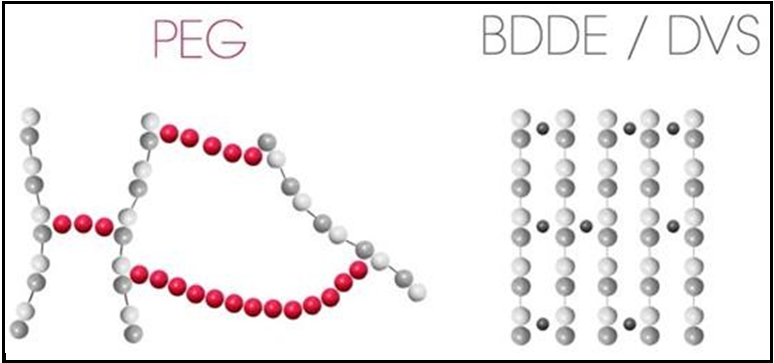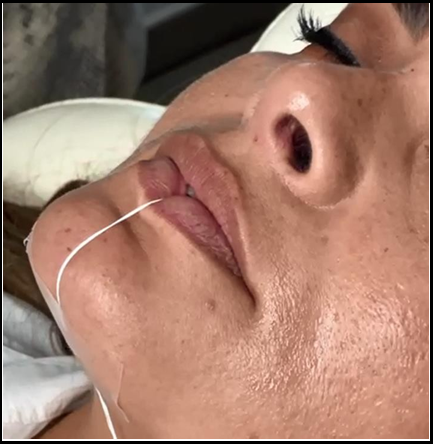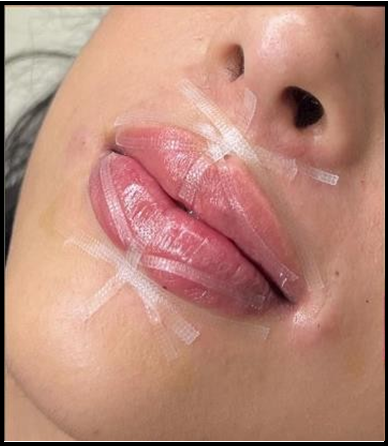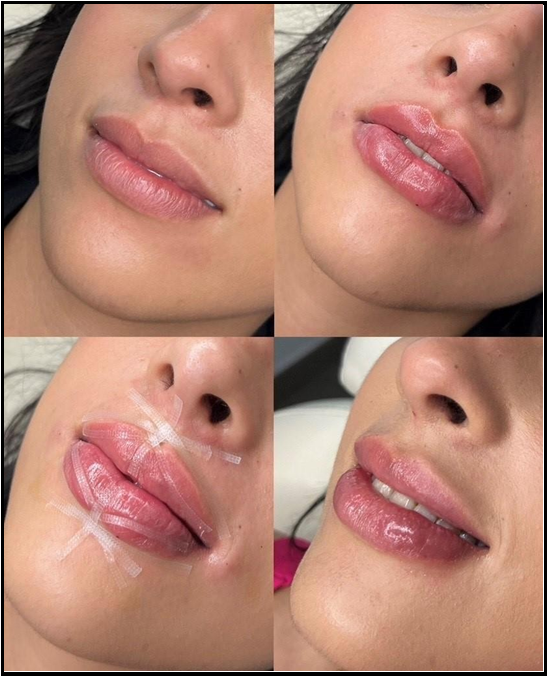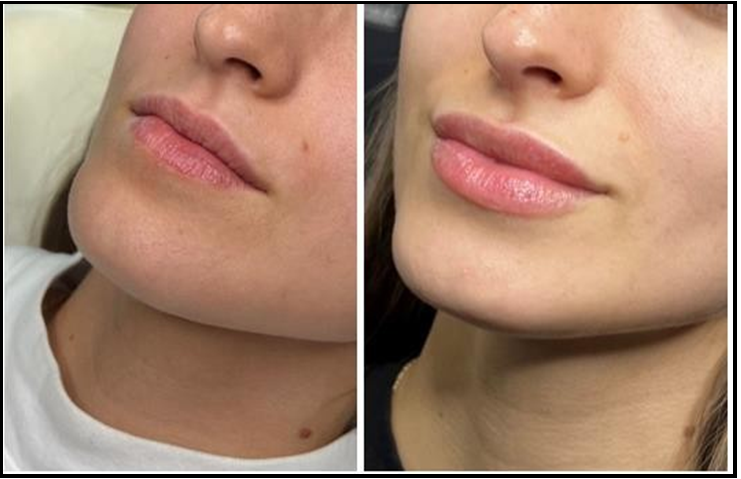Laura Luna*
Clinique Lune Beauté, Av. López de Legazpi 1870 Col. Jardines de la Cruz, Guadalajara, Mexico
*Corresponding Author: Laura Luna, Clinique Lune Beauté, Av. López de Legazpi 1870 Col. Jardines de la Cruz, Guadalajara, Mexico.
Abstract
Aim: The aim of the study was to evaluate the lip rejuvenation protocol developed by the author in terms of effectiveness, safety and patient satisfaction.
Methods: 55 female subjects underwent a lip beautification procedure. The hyaluronic acid filler 24 mg/ml HA hydrogel crosslinked with polyethylene glycol diglycidyl (PEGDE-HA 24) (Matex Lab S.A. Intense Lips, Geneva, Switzerland) was used for lip correction using the developed "Latin Lips" technique. The Global Aesthetic Improvement Scale was used to assess the effects of the treatments (SGAIS, PGAIS), subject satisfaction scale and Lips Fullness Scale. Adverse events were monitored as well.
Results: All subjects tolerated the procedure well, and there were no adverse events reported. The mean scores reported in the study were rated at “very much improved” and “much improved” at 93% (SGAIS) and 91% (PGAIS), as well as subject satisfaction at 93%, indicating significant improvement after the treatment. The dermal filler used showed a high degree of biointegration, with excellent volume and lifting capacity in all subjects, and the investigator reported a very interesting relationship between the amount of product used and the effect achieved.
Conclusion: The procedure performed on 55 patients using PEGDE crosslinked hyaluronic acid-based dermal filler using the injection technique developed by the author gave highly satisfactory results for both the investigator and all subjects. The procedure was not associated with any adverse events.
Keywords: lip augmentation, lip rejuvenation, redefinition, volumization, hyaluronic acid, polyethylene glycol diglycidyl ether, Latin lips
Introduction
The face, especially a beautiful smile, is our business card, the area we pay most attention to and which plays a huge role in our everyday interpersonal relationships. Pretty faces are somehow automatically assigned more attractive, likable and pleasant personality traits. [1,2,3] It is therefore not surprising that aesthetic medicine treatments are extremely popular, aimed at restoring or obtaining a harmonious, attractive and proportionate appearance of the face, lips, and smile. [4,5] Beauty standards are constantly changing, what was considered attractive 10, 20 or 30 years ago is no longer so. New fashion trends, cultural influences, social media influence what we perceive as attractive and desirable. Currently, profiles with protruding lips are considered the most attractive. [6,7,8] When planning the procedure, it is important to take into account the patient's preferences and his or her perception of attractiveness, the feasibility of carrying out the procedure, as well as adapting the product and technique used. There are a plenty of techniques related to augmentation, correction and lip modelling.
We assessed the effectiveness, safety and patient satisfaction with the use of lips rejuvenation protocol using a novel technique developed by the author.
Methods
55 female patients underwent the Latin Lips procedure developed by the author for lip augmentation and correction using 24 mg/ml HA hydrogel crosslinked with polyethylene glycol diglycidyl (PEGDE- HA 24) (Matex Lab S.A. Intense Lips, Geneva, Switzerland). Latin Lips treatments were performed on all described patients in 2022- 2023. The author was the only doctor performing the procedures.
Hyaluronic acid filler used in the procedure
Soft tissue fillers based on hyaluronic acid are currently the most frequently used fillers in facial volume deficiencies, including the procedures focused on lips augmentation or facial contouring. They owe their popularity to the long-lasting and, at the same time, the reversible effect of improving facial aesthetics in the event of signs of aging. Soft tissue fillers, although they are based on hyaluronic acid, their properties may differ, both in terms of rheology, viscoelastic properties, or heat resistance (Figure 1). For this procedure the 24 mg/ml HA filler crosslinked with polyethylene glycol diglycidyl was used.
Polyethylene glycol diglycidyl (PEGDE), used as a filler cross- linking agent, is creating the so called PEGylation [9,10,11], which significantly affects the effects of treatments - both in terms of aesthetic effects and safety. The cross-linking agent and hyaluronic acid are polymers, and the cross-linking process allows to create 3D matrices with scaffold structure [12,13,14], which results in better biointegration of the filler with the tissue at the site of administration.
Thanks to cross-linking using PEGDE, the resulting filler is characterized by excellent rheological properties, with optimized adaptation and biointegration with the tissues where the filler was injected. [15,16]
Figure 1: Hyaluronic acid is cross-linked with various cross-linking agents.
Latin Lips – Injection Procedure
Latin Lips is a hybrid technique dedicated to the lips. We can tailor- make and adopt it for the patient's lips and needs without compromising their natural shape. It gives volume and contour using a low amount of hyaluronic acid. The choice of filler for such a dynamic area as the lips is one of the key factors ensuring the success of the procedure. For our technique, we used the 24 mg/ml HA filler crosslinked with polyethylene glycol diglycidyl.
1. Patient selection
One can assume that "Latin Lips" is for everyone, however "Latin Lips" is for patients wanting medium volume and contour, resulting in defined and voluptuous natural lips. Naturalness and maintaining the proportions of the lips, as well as the aesthetics of the complete face, were crucial in the development of this technique.
2. Preparation
Respecting the principles of sterility, a topical antimicrobial agent (Octenisept) which consist of octenidine hydrochloride 0.1% and phenoxyethanol 2% was used. Followed by (an important aspect) strategically place a divider interdentally dividing the lower tubercles (Figure 2).
Figure 2: Placement method of a divider interdentally dividing the lower tubercles.
3. Anesthesia
0.5 ml of 2% lidocaine was placed with a 30 G x 9 mm syringe, applied to both piriformis fossae, blocking the infraorbital nerve at a 90° angle. With the same caliber of syringe, 2% lidocaine is placed with a subcutaneous technique 0.5 cm from both corners of the mouth (Figure 3).
Figure 3: Method of administering anesthesia.
4. Application technique
An entry point is made with a 25 G x 27 mm needle at 90°. A microcannula 27 G x 40 mm is placed on a PEGDE-HA 24 hyaluronic acid syringe. The cannula is inserted at 90° with the golf flag technique at a depth of 0.05 cm.
We rotate the cannula at 45°, introducing it to the upper left central posterior compartment, where we place 0.1 ml of hyaluronic acid in a small fanning technique. After this, we do another fanning technique, placing 0.04 ml in the deep medial upper left compartment and the upper left lateral compartment deep 0.01ml. By means of this sandwich-technique we create three layers which is based on the desired volume and thickness of the lip. We place the tong depressor on the cutaneous lip, protecting the border of the cutaneous lip and dry mucosa (vermillion border) to help ensure that the hyaluronic acid remains inside the red portion of the lip during the injection. The same technique and approach is applied to the contralateral side.
Once we have augmented the upper lip, we move to the lower lip. We rotate the cannula at 45° introducing it to the lower left central posterior compartment where we place 0.06 ml of hyaluronic acid in a small fanning technique. Next, we do a fanning technique, placing 0.03 ml in the lower left medial anterior compartment and 0.01 ml in the lower left lateral compartment. Again, using this sandwich- technique we create layers which is based on the desired volume and thickness of the lip. We place tongue depressors between the white lip and the red lip to help ensure that the hyaluronic acid remains inside the red lip during our application. The same technique and approach is applied to the contralateral side.
We go to the edge of the red lip on the upper right tubercle using a “blanching” technique, reaching the highest part of the cupid's bow with a depth of 0.03 mm. Covering the three compartments of the upper right tubercle (Figure 4 A-F).
Figure 4: A-F. Visual step-to-step approach the Latin Lips technique, full description above.
5. Compression tape
A latex-free, hypoallergenic, transparent, macro-perforated plastic medical tape is placed on both lips. Its main task is to reduce swelling and accelerate recovery, without limiting the mobility of this area (Figure 5). Post procedure all patients moisturized lips with the manufacturer’s lip balm (Neauvia Lip Bliss 3D hyaluronic acid volumizer).
Figure 5. Placement of compression tape on both lips.
Results
Injection volume was determined by the physician and tailormade per patient, but volumes did not exceed 1.0 ml. No touch-up treatments were needed. The physician followed up on a regular basis (Visit 1: 24 - 48 hours after the procedure, visit 2: 7-10 days after the procedure, visit 3: 20-25 days after the procedure, visit 4: 40-45 days after the procedure) and solicited regular subjects feedback to follow the progress of treatment results (Figure 6,7). It was noticeable that the level of swelling was very low, and the shape of lips was fuller, rounder. Patients reported that their lips had healed very quickly, compared to their experience with other lip fillers they have received in the past.
Figure 6: Patient before treatment and immediately after injections of PEGDE-HA 24 for lip augmentation with Latin Lips technique.
Figure 7. Subject before and 45 days after the initial treatment.
The subjects reported no bruising, no swelling, and no other side events, and were still very satisfied with the results (Table 1).
Table 1: Satisfaction levels of both patients and doctor after the Latin lip’s procedure
|
Subject Satisfaction |
|
|
Very Satisfied & satisfied |
93% |
|
Physician Global Aesthetic Improvement Scale (PGAIS) |
|
|
Very much improved & much Improved |
91% |
|
Subject Global Aesthetic Improvement Scale (SGAIS) |
|
|
Very much improved & much Improved |
93% |
The subjects and doctor reported the same grade in terms of lip fullness after forth follow up visit (Table 2). The intended goal of the treatment was only to restore, slightly add volume and highlight the contour of the lips, giving them a youthful, natural appearance. 40-45 days after the initial visit an aesthetic difference could still be well observed.
Table 2: Lip fullness scale – reported after forth follow up visit.
|
Lip Fullness Scale |
Doctor evaluation |
Patient evaluation |
|
Moderate thick |
73% |
73% |
|
Thick |
16% |
16% |
|
Full |
0% |
0% |
Patients were also asked about their subjective assessment of the appearance of their lips and satisfaction with the procedure, the results are summarized below (Table 3). Improvements in the examined indicators were declared by:
Table 3. Patient Satisfaction Survey results after Latin Lips procedure.
|
Lip smoothness |
91% |
|
Lip plumpness |
95% |
|
Lips contour definition |
91% |
|
Decrease in chapped lips |
93% |
Discussion
The lips are of great importance for the perception of beauty by humans, they are an important element of facial symmetry and aesthetics. [17] Aesthetic medicine treatments involving lip modification, modelling and correction have recently gained popularity, but in some cases the results are disastrous. There is a huge number of techniques, products, indications, and views on the aesthetics and proportions of the lips and face. In the pursuit of the desired appearance, both the patient and the doctor performing the procedure should primarily focus on the naturalness of the effect, perception of facial attractiveness, selection of the product, and technique that ensures the optimal effect. In this publication, we describe the lip correction technique developed by the author. Latin Lips technique can be tailor-made and adopted for the patient's lips and needs without compromising their natural shape, giving volume and contour using a low amount of hyaluronic acid. The visual effect and the satisfaction rating of the patient and doctor after the procedure, which remains above 90%, prove the excellent acceptance of this treatment protocol, as well as the appropriate choice of the product used, ensuring an excellent effect with a small amount of filler. The treatment protocol allows satisfactory and reproducible results, which can be achieved with low amounts of filler, which has a beneficial effect on the final aesthetic effect and the patient's recovery. The dermal filler used for this technique was an HA, a concentration of with 24 mg/ml and crosslinked with polyethylene glycol diglycidyl and was effective at augmenting lip volume and improving lip shape and profile, without any side events.
Conclusion
Beauty, attractiveness, and perception of one's own body have many dimensions and these issues can be viewed from different perspectives, which are influenced by age, gender, ethnicity and social media. [18] The market and demand for treatments to improve the appearance of the lips are constantly developing and growing. As interest increases, so does the demand for new treatment protocols, techniques and products. In this case of the Latin Lips technique, we reported the safety and results of lip beautification using the developed technique by the author and PEGDE-HA filler.
Despite the number of patients and limited follow-up time, the presented Latin Lips technique turned out to be effective and safe and was highly appreciated by patients. At the aesthetic level, the Latin Lips technique presented in the study significantly improved facial proportions, patient satisfaction and demonstrated effectiveness and excellent aesthetic results. These outcomes were also obtained with less product used in comparison to any other filler available on the market suitable for the lips. The effect obtained was natural and in line with the expectations of the patient and the doctor. The technique used, as well as the PEGDE cross-linked product, turned out to be safe and did not cause any adverse events.
List Of Abbreviations
HA - hyaluronic acid.
PEGDE - poly (ethylene glycol) diglycidyl ether
BDDE - butanediol diglycidyl ether
DVS - divinyl sulfone
PEGDE-HA 24 - Neauvia Intense Lips, Matex Lab SA, Switzerland
Declarations
Authors’ contributions
Single author: Laura Luna
The author contributed solely to the article.
Availability Of Data And Materials:
The data presented in this publication are available on request from the corresponding author. The data are not publicly available due to privacy restrictions.
Financial support and sponsorship: None.
Conflicts of interest
Dr Laura Luna is self-employed in her clinic “Lune Beaute” in Mexico. Dr Laura Luna is a consultant and KOL for Matex Lab S.A. No logistical and financial support for the execution of this study was given.
Ethical approval and consent to participate.
Not applicable. Medical documentation analysis. The study was conducted in accordance with the Declaration of Helsinki.
Consent for publication.
Informed consent was obtained from the subject involved in the report. Written informed consent has been obtained from the patient to publish this paper.
References
- Sieja A, Kawala B (2014) Contemporary orthodontic diagnostics. Dent Med Probl. 51(1): 19–25.
- Faure JC, Rieffe C, Maltha JC (2002) The influence of different facial components on facial aesthetics. Eur J Orthod. 24(1): 1–7.
- Cunningham MR, Barbee AP, Pike CL (1990) What Do Women Want? Facialmetric Assessment of Multiple Motives in the Perception of Male Facial Physical Attractiveness. J Pers Soc Psychol. 59(1): 61–72.
- International Society of Aesthetic Plastic Surgeons (ISAPS). ISAPS international survey on aesthetic/cosmetic procedures performed in 2021.
- American Society of Plastic Surgeons (ASAPS). Plastic surgery statistics report 2020.
- Matoula S, Pancherz H (2006) Skeletofacial morphology of attractive and nonattractive faces. Angle Orthod. 76(2): 204-10.
- Türkkahraman H, Gökalp H (2004) Facial profile preferences among various layers of Turkish population. Angle Orthod. 74(5): 640–647.
- Czarnecki ST, Nanda RS, Currier GF (1993) Perceptions of a balanced facial profile. Am J Orthod Dentofac Orthop. 104(2): 180–187.
- Roberts MJ, Bentley MD, Harris JM (2002) Chemistry for peptide and protein PEGylation. Adv Drug Deliv Rev. 54(4): 459-76.
- Park YD, Tirelli N, Hubbell JA (2003) Photopolymerized hyaluronic acid-based hydrogels and interpenetrating networks. Biomaterials. 24(6): 893-900.
- Jin R, Moreira Teixeira LS, Krouwels A, Dijkstra PJ, van Blitterswijk CA, et al. (2010) Synthesis and characterization of hyaluronic acid-poly(ethylene glycol) hydrogels via Michael addition An injectable biomaterial for cartilage repair. Acta Biomater. 6(6): 1968-77.
- Leach JB, Schmidt CE (2005) Characterization of protein release from photocrosslinkable hyaluronic acid- polyethylene glycol hydrogel tissue engineering scaffolds. Biomaterials. 26(2): l25- l35.
- Hassan W, Dong Y, Wang W (2013) Encapsulation and 3D culture of human adipose-derived stem cells in an in-situ crosslinked hybrid hydrogel composed of PEG-based hyperbranched copolymer and hyaluronic acid. Stem Cell Res Ther. 4(2): 32.
- Aurand ER (2014) The characterization of hyaluronic acid and polyethylene glycol hydrogels for neural tissue engineering. Neuroscience and Biomedical Engineering Thesis, University of Colorado, Denver, Anshutz Medical Campus. l72 pages; Publ. #3622545.
- Zerbinati N, D'Este E, Farina A, Rauso R, Cherubino M, et al. (2017) Morphological evidences following pegylated filler treatment in human skin. J Biol Regul Homeost Agents. 31(2 Suppl 2): 79-85.
- Zerbinati N, Sommatis S, Maccario C, Capillo M.C, Grimaldi G, et al. (2021) Toward Physicochemical and Rheological Characterization of Different HA Dermal Fillers Cross-Linked with Polyethylene Glycol Diglycidyl Ether. Polymers. 13(6): 948.
- Kar M, Muluk NB, Bafaqeeh SA, Cingi C (2018) Is it possible to define the ideal lips? Acta Otorhinolaryngol Ital. 38(1): 67-72.
- Adamek A, Sarul M, Lis J, Kobiela Z, Kiełczawa M, et al. (2022) Influence of Lip Projection and Chin Position on Facial Profile references Among Various Layers of Polish Population. Part 1. Clin Cosmet Investig Dent. 14: 253-263.




